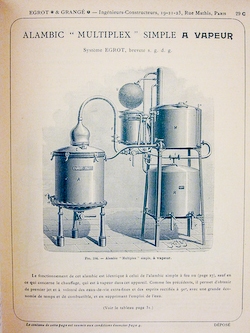From the 1800s to the Present Day
The history of the alembic continued slowly through the centuries until the 19th century when the era of technology flourished. Taking inspiration from Della Porta's intuition, the Florentine Baglioni devised the distillation column in 1813, inserting small plates with bells and downcomer tubes inside it. In this way, it was like having multiple alembics stacked on top of each other, and the distillate that emerged was richer in alcohol, abbreviating the entire process.
However, it was only in the mid-19th century that the great Louis Pasteur defined the real nature of yeasts and their importance in the fermentation process, allowing for a deeper understanding of alcohol preparation. His research became fundamental for oenology, marking a decisive watershed between ancient and modern winemaking.
However, it was only in the mid-19th century that the great Louis Pasteur defined the real nature of yeasts and their importance in the fermentation process, allowing for a deeper understanding of alcohol preparation. His research became fundamental for oenology, marking a decisive watershed between ancient and modern winemaking.
In the early 20th century, when the process of alcoholic fermentation was fully understood, important scholars, both Italian and foreign, rationally applied it to production processes, refining distillation plants.
Thus was born the modern distillation industry and with it, the commercial and fiscal need to accurately measure the alcohol content of spirits.
In this context, a particularly noteworthy mention goes to Enrico Comboni (1850-1900), founder and first director of the Chemistry Laboratory at the Enological Institute of Conegliano. He perfected the steam distillation technique remarkably and structured the still so that the grape pomace placed inside the boiler would be crossed by a flow of steam, carrying with it aromas and alcoholic substances. This method, although with various subsequent modifications, was of paramount importance considering that today, more than 90% of Grappa produced is steam distilled.
Thus was born the modern distillation industry and with it, the commercial and fiscal need to accurately measure the alcohol content of spirits.
In this context, a particularly noteworthy mention goes to Enrico Comboni (1850-1900), founder and first director of the Chemistry Laboratory at the Enological Institute of Conegliano. He perfected the steam distillation technique remarkably and structured the still so that the grape pomace placed inside the boiler would be crossed by a flow of steam, carrying with it aromas and alcoholic substances. This method, although with various subsequent modifications, was of paramount importance considering that today, more than 90% of Grappa produced is steam distilled.



